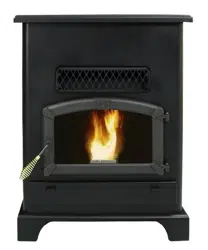Loading ...
Loading ...
Loading ...

17
Creosote Formation – When any wood is burned slowly, it produces tar and other organic vapors, which combine with
expelled moisture to form creosote. The creosote vapors condense in the relatively cool chimney ue or a newly started
re or from a slow-burning re. As a result, creosote residue accumulates on the ue lining. When ignited, this creosote
makes an extremely hot re, which may damage the chimney or even destroy the house. Despite their high efciency,
pellet stoves can accumulate creosote under certain conditions.
Fly Ash – This accumulates in the horizontal portion of an exhaust run. Though non-combustible, it may impede the
normal exhaust ow. It should therefore be periodically removed.
Inspection and Removal – The chimney connector and chimney should be inspected annually or per ton of pellets to
determine if a creosote or y ash build-up has occurred. If creosote has accumulated, it should be removed to reduce
the risk of a chimney re. Inspect the system at the stove connection and at the chimney top. Cooler surfaces tend to
build creosote deposits quicker, so it is important to check the chimney from the top as well as from the bottom. The
creosote should be removed with a brush specically designed for the type of chimney in use. A qualied chimney sweep
can perform this service. It is also recommended that before each heating season the entire system be professionally
inspected, cleaned and, if necessary, repaired. To clean the chimney, disconnect the vent from the stove.
Periodically remove and clean the burn pot and the area inside the burn pot housing. In particular it is advisable to
clean out the holes in the burn pot to remove any build up that may prevent air from moving through the burn pot freely.
Remove the two(2) plates on each side of the burn pot housing and clean out that rear chamber.
If a vacuum is used to clean your stove, we suggest using a vacuum designed for ash removal. Some regular vacuum
cleaner (i.e. shop vacs) may leak ash into the room.
Ashes should be placed in a metal container with a tight tting lid. The closed container of ashes should be placed on
a noncombustible oor or on the ground, well away from all combustible materials, pending nal disposal. If the ashes
are disposed of by burial in soil or otherwise locally dispersed, they should be retained in the closed container until all
cinders have been thoroughly cooled. The container shall not be used for other trash or waste disposal.
Check the hopper periodically to determine if there is any sawdust or pellets that are sticking to the hopper surface.
Clean as needed.
Inspect the main door and glass window gaskets periodically. The main door may need to be removed to have frayed,
broken, or compacted gaskets replaced by your authorized dealer. The glass gasket has a gap at the bottom for the
airwash.
Clean the air holes on the motors of both the exhaust and distribution blowers annually. Remove the exhaust blower
from the exhaust duct and clean out the internal fan blades as part of your fall start-up.
Painted surfaces may be wiped down with a damp cloth. If scratches appear, or you wish to renew your paint, contact
your authorized dealer to obtain a can of suitable high-temperature paint.
Maintenance
Loading ...
Loading ...
Loading ...
